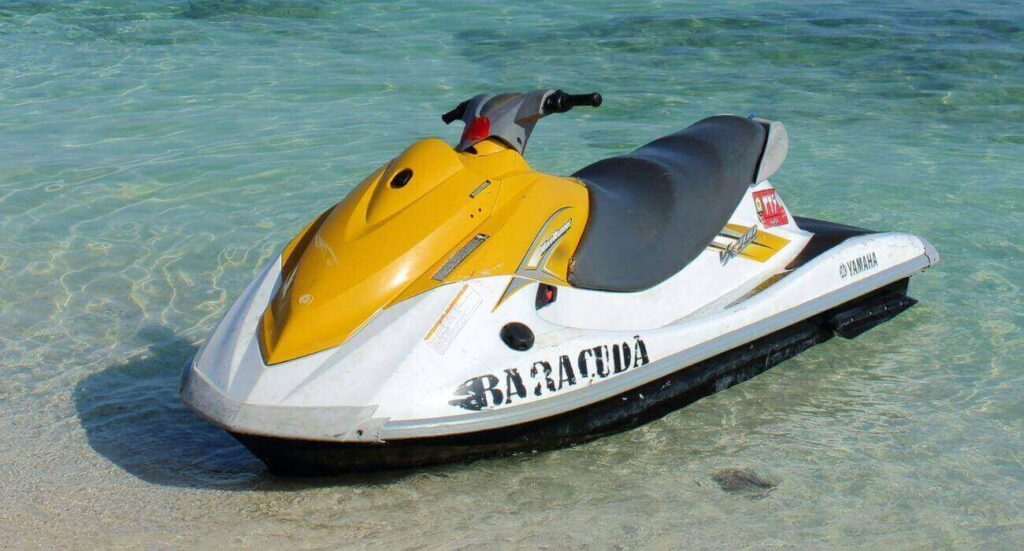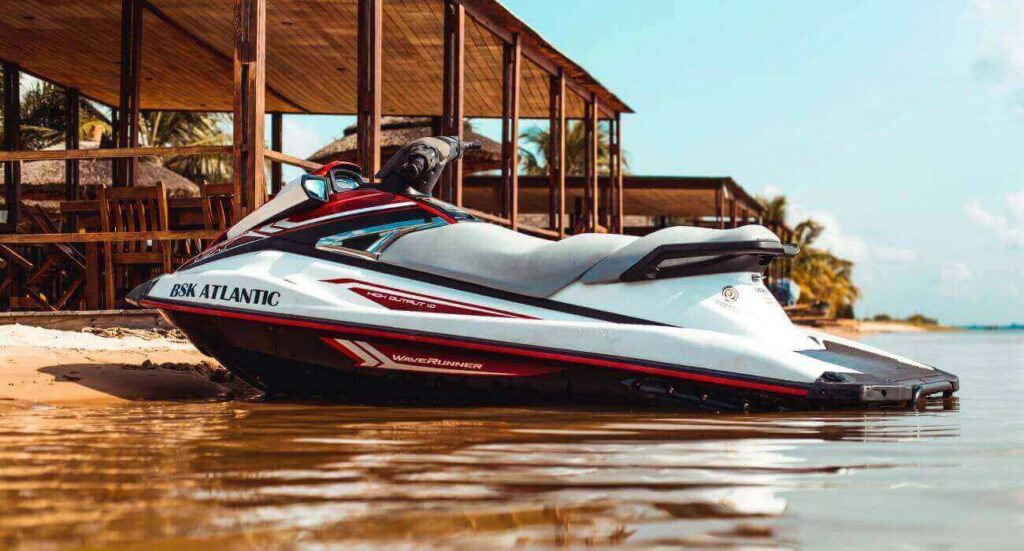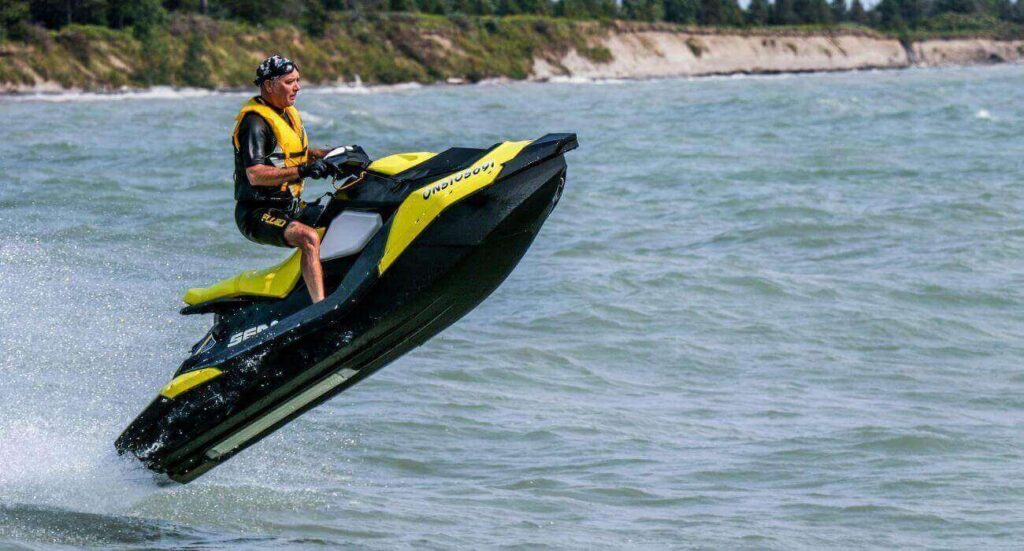As an Amazon Associate, I earn from qualifying purchases
A jet ski generates forward thrust by using a unique impeller that draws water into a propulsion channel and forces it out through a cone-shaped jet nozzle. This design allows the jet ski to move efficiently through the water and achieve high speeds.
By spraying a high stream of water, jet skis ensure visibility and safety, making them noticeable to other watercraft and jet skiers. The water is drawn into the jet ski engine through an intake grate located at the bottom of the hull, which is used by the jet pump for propulsion and engine cooling.
The jet propulsion engine of a jet ski uses rotating fan blades on the impeller to suck in water and forcefully eject it, propelling the jet ski forward.
How Does A Jet Ski Work?

Jet skis are popular watercraft used for recreational activities and water sports. They provide an exhilarating experience as riders zoom across the water’s surface. But have you ever wondered how a jet ski actually works? In this blog post, we will dive into the mechanics of a jet ski to understand its inner workings and what makes it move.
Impellers
One of the key components of a jet ski is the impeller. The impeller is responsible for generating forward thrust and propelling the watercraft through the water. It works using a unique “corkscrew” motion, drawing in a large volume of water into a propulsion channel. The impeller then forces the water out through a size-restricted cone-shaped jet nozzle, creating propulsion.
Power Source
Jet skis are typically powered by internal combustion engines, similar to those found in motorcycles or cars. These engines can be either two-stroke or four-stroke, depending on the model. The engine drives the impeller, which in turn generates the thrust required to propel the jet ski forward.
Steering
Steering a jet ski is accomplished through the use of a handlebar system. By turning the handlebars, the rider can control the direction in which the jet ski moves. The handlebars are connected to a steering nozzle, which can redirect the flow of water exiting the jet nozzle. This redirection of water flow allows the rider to maneuver the jet ski and navigate through the water.
In conclusion, jet skis work by utilizing impellers to generate forward thrust, powered by internal combustion engines, and steered through handlebar-controlled steering nozzles. Understanding the mechanics behind how a jet ski works can enhance your experience on the water and give you a deeper appreciation for this exciting watercraft.
The Physics Behind Jet Ski Propulsion

Jet skis are a thrilling water vehicle that allows you to zip across the water’s surface with speed and agility. But have you ever wondered how a jet ski actually works? The key to its impressive performance lies in the physics of its propulsion system.
Jet Propulsion Pump
At the heart of a jet ski’s propulsion system is the jet propulsion pump. This pump uses a unique “corkscrew” style impeller to generate forward thrust. It operates by drawing a large volume of water into a propulsion channel and then forcing it out through a size-restricted cone-shaped jet nozzle. This process creates a powerful jet of water that propels the jet ski forward at high speeds.
Advantages Of Waterjet Propulsion
Waterjet propulsion offers several advantages over other forms of propulsion. First and foremost, it eliminates the need for any external propeller or propeller shaft, resulting in a streamlined design that reduces the risk of damage from underwater obstacles. Additionally, waterjet propulsion provides excellent maneuverability and responsiveness, allowing riders to make quick turns and navigate tight spaces with ease. This makes jet skis well-suited for recreational activities and water sports.
Steering And Controls
Steering a jet ski involves a combination of handlebar controls and the redirection of the water jet. By turning the handlebars, the rider can adjust the direction of the jet ski. This, in turn, alters the flow of water ejected from the jet nozzle, allowing for precise steering. Other controls, such as throttle and brake, are also conveniently located on the handlebars, making it easy for riders to operate the jet ski.
Jet Ski Components And Operation

A Jet Ski, also known as a personal watercraft (PWC), is an exhilarating watercraft that provides high-speed thrills on the water. Before hopping on a Jet Ski and racing across the waves, it’s essential to understand how it works. In this section, we will explore the different components of a Jet Ski and how they contribute to its operation.
Jet Pump
The jet pump is a crucial component of a Jet Ski that enables propulsion through the water. It consists of an impeller and a jet nozzle. The impeller, which resembles a corkscrew, draws a large volume of water into a propulsion channel within the Jet Ski. This water is then forced out through a cone-shaped jet nozzle, creating forward thrust and accelerating the Jet Ski.
Intake And Exhaust Systems
The intake system of a Jet Ski is responsible for drawing water into the engine for propulsion and cooling. Located at the bottom of the hull, an intake grate allows water to flow into the engine compartment. The water then passes through various filters and reaches the impeller, where it is used for propulsion.
On the other hand, the exhaust system is responsible for expelling the combustion gases generated by the engine. These gases are directed out of the Jet Ski through an exhaust outlet, ensuring proper engine performance and preventing overheating.
Cooling Systems
To prevent the engine from overheating, Jet Skis are equipped with cooling systems. These systems utilize water from the surrounding environment to cool down the engine. As water enters the intake system, it passes through the engine’s heat exchanger, which transfers the excess heat from the engine to the water. The heated water is then expelled through the exhaust system, while cooler water is circulated back into the engine to maintain its optimal temperature.
| Jet Pump | Intake and Exhaust Systems | Cooling Systems |
|---|---|---|
| Impeller | Intake Grate | Heat Exchanger |
| Jet Nozzle | Filters | Water Circulation |
Understanding the components and operation of a Jet Ski is vital for safe and enjoyable watercraft experience. The jet pump, intake and exhaust systems, and cooling systems all play crucial roles in propelling the Jet Ski through the water and ensuring optimal engine performance.
Frequently Asked Questions For How Does A Jet Ski Work
How Does A Jet Ski Move Water?
A jet ski moves water by using a unique impeller that draws in a large volume of water and forces it out through a cone-shaped jet nozzle. This creates forward thrust and propels the jet ski.
Why Do Jet Skis Shoot Water Up?
Jet skis shoot water up to ensure visibility and safety. By spraying a high stream of water, they can be easily seen by other watercraft and jet skiers. This is similar to the concept of dune buggies using orange flags for visibility.
How Does Water Get Into A Jet Ski Engine?
Water gets into a jet ski engine through an intake grate located at the bottom of the hull. The engine draws the water in for propulsion and sometimes for cooling.
Can You Run A Jet Ski Out If Water?
No, you cannot run a jet ski out of water. The engine of a jet ski requires water for cooling and propulsion. Running the motor without water can damage the engine.
Conclusion
To understand how a jet ski works, it’s important to note its key components, such as the impeller and jet nozzle. The impeller draws water into the propulsion channel, creating forward thrust. The water is then forced out through the jet nozzle, propelling the jet ski forward.
This design allows for maneuverability and speed on the water. Additionally, jet skis spray water up for safety and visibility purposes. By incorporating these mechanisms, jet skis offer an exhilarating and safe experience on the water.
As an Amazon Associate, I earn from qualifying purchases

